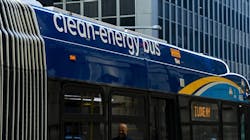MTA commits to reducing emissions by at least 85 percent by 2040
The Metropolitan Transportation Authority (MTA) has committed to reducing the emissions that result from operations of the authority’s trains, buses and facilities by at least 85 percent by 2040 from a 2015 baseline. MTA also released a new analysis showing the authority’s operations help New Yorkers avoid emitting 20 million metric tons of carbon annually, by keeping cars off the road, reducing congestion and enabling high-density neighborhoods.
“There is no denying the urgent need to address the climate crisis, and the MTA is a double solution, first by providing New Yorkers with environmentally sustainable form of transportation and second, by finding innovative ways to reduce our own emissions,” said MTA Chair and CEO Janno Lieber. “Now more than ever, New Yorkers can feel confident that by riding the MTA, they are doing their own part to reduce climate impacts.”
Steps MTA is taking to lower emissions
- Updating Facilities: MTA will update legacy systems in shops, depots, yards and stations, with energy efficient tech and low- or no-emissions systems as part of its capital program investments. The MTA will upgrade HVAC and lighting systems to be more energy efficient, identify opportunities to transition away from fossil fuel heating systems where feasible and invest in solar panel installations on facility rooftops.
- Transitioning Fleets: The MTA will take steps to reduce emissions associated with all fleets. Notably, the MTA will transition its entire bus fleet of 5,800 buses to zero emission alternatives by 2040. In 2019, the MTA purchased 15 electric buses and installed 16 chargers at the MJ Quill Depot. Work on the path to a full transition by 2040 includes taking delivery of the pilot buses from MTA’s 60 all-electric bus order, awarding the procurement of 470 all-electric buses, equipping bus depots with new state-of-the-art charging infrastructure to support the MTA's growing electric bus fleet and expanding a depot-based workforce training program for zero-emissions.
- Increasing Energy Efficiency: By using energy management technologies, regenerative energy and power storage and deploying on-site renewable energy installations. The MTA is already installing remote controls for third rail heaters to reduce energy usage, one of more than 200 efficiency projects the MTA has already completed across its agencies.
In addition to reducing emissions, the authority is committing to meet the state’s goal for an equitable green energy transition by prioritizing efforts that impact disadvantaged communities. Environmental justice communities that have historically been disproportionately impacted by pollution will be prioritized for the first electrified buses and routes, thereby reducing emissions that cause harmful and lasting health effects.
“Subways and buses are moving over five million people daily, a feat that would take millions of cars to accomplish,” said New York City Transit President Richard Davey. “Simply deciding to take transit daily is good for the environment. With New York City Transit’s commitment to a zero-emissions bus fleet by 2040, that daily decision to take the bus or subway will get even greener.”
Lowering emissions is the first step toward the MTA aligning the entire agency behind sustainability and climate resilience as core goals for the future under a Climate Sustainability Framework. Formally incorporating the role of climate in the long-term planning process, the MTA expects to include sustainability and climate resiliency as key criteria this fall as it releases its Twenty-Year Needs Assessment, the key document that will guide the renewal, upgrade and expansion of New York’s subways, buses and commuter railroads, as well as its nine bridges and tunnels linking the five boroughs of New York City.
